-
01-01-2016
ERRATUM
Revista Brasileira de Enfermagem. 2016;69(1):206-206
Abstract
ERRATUM
Revista Brasileira de Enfermagem. 2016;69(1):206-206
DOI 10.1590/0034-7167.20166901e02
Views0In the article “Conceptions of mid-level nursing professionals facing those with a chemical dependency”, with the number of DOI: 10.1590/0034-7167.2015680610i, published in the journal Revista Brasileira de Enfermagem, v68(6):755-60, page 760 that read: “8. Vargas D, Soares J. Knowledge and attitudes of nurses towards alcohol and related problems: the impact of an educational intervention. Rev […]See more -
01-01-2016
ERRATUM
Revista Brasileira de Enfermagem. 2016;69(1):205-205
Abstract
ERRATUM
Revista Brasileira de Enfermagem. 2016;69(1):205-205
DOI 10.1590/0034-7167.20166901e01
Views0In the article “Using the theory of meaningful learning in nursing education”, with the number of DOI: 10.1590/0034-7167.2015680420i, published in the journal Revista Brasileira de Enfermagem, v68(4):626-35, page 627 that read:“Ausubel was descended from Jewish, born in New York in 1918 and died in 1994 at the age of 75. He thought and wrote until […]See more -
01-01-2016
Nursing process documentation: rationale and methods of analytical study
Revista Brasileira de Enfermagem. 2016;69(1):197-204
Abstract
Nursing process documentation: rationale and methods of analytical study
Revista Brasileira de Enfermagem. 2016;69(1):197-204
DOI 10.1590/0034-7167.2016690126i
Views0See moreABSTRACT
Objective:
to describe the methods used to analyze the associations between variables of service, nursing and the nursing process documentation in institutions of the Department of Health of the State of São Paulo.
Method:
multilevel analytical study with data obtained in the domains of institution, units of the institution and nursing professionals who work there, using standardized instruments. The analyses had as axis the degree of completeness of the nursing process documentation in units or institutions and their association with variables of nursing personnel, of units and of institutions.
Conclusion:
This study will provide important empirical evidence on the factors involved in the nursing process documentation.
-
01-01-2016
Qualitative methodologies in health research: interpretive referential of Patricia Benner
Revista Brasileira de Enfermagem. 2016;69(1):192-196
Abstract
Qualitative methodologies in health research: interpretive referential of Patricia Benner
Revista Brasileira de Enfermagem. 2016;69(1):192-196
DOI 10.1590/0034-7167.2016690125i
Views0See moreABSTRACT
Objective:
this article reports on the experience of using the interpretive phenomenological framework of Patricia Benner in a Brazilian context. Benner’s interpretive phenomenology, based on existential and interpretative philosophy, aims to understand human experiences in the particular worlds of research participants. Data were collected through interviews with nine nurses in November and December 2014.
Results:
data analysis process according to Benner’s framework consisted of: transcription, coding, thematic analysis, and search for paradigmatic cases and examples. Therefore, the prior knowledge of the researcher is an important part of the study, consisting in manners of the research conduction.
Conclusion:
The use of this methodological framework entailed a great challenge for the researcher, however, it also enabled a unique opportunity to illuminate important existential phenomena related to the daily lives of research participants.
-
01-01-2016
Nurses’ performance on primary care in the National Health Service in England
Revista Brasileira de Enfermagem. 2016;69(1):182-191
Abstract
Nurses’ performance on primary care in the National Health Service in England
Revista Brasileira de Enfermagem. 2016;69(1):182-191
DOI 10.1590/0034-7167.2016690124i
Views0See moreABSTRACT
Objective:
To analyze the expansion of nursing roles in primary care in the English National Health Service and the implications for professional practice.
Method:
qualitative research in case study format, held in London, England, in six primary care units. Data were obtained through interviews with nine nurses. After the thematic data analysis, two units emerged: the nurses’ performance characteristics and effects of the expansion of nursing roles.
Results:
expansion of nurses’ roles: consultation, diagnosis and drug therapy, case management and monitoring of chronic conditions. Repercussions: for the user, there was improved access, communication and comprehensive care, increased duration of consultations, resulting in greater adherence; for nurses, there was the expansion of professional skills, knowledge and professional recognition; to the health care system, it resulted in cost savings.
Conclusion:
benefits in expanding nursing roles, were visible, contributing to primary care quality.
-
01-01-2016
Meleis’ Nursing Theories Evaluation: integrative review
Revista Brasileira de Enfermagem. 2016;69(1):174-181
Abstract
Meleis’ Nursing Theories Evaluation: integrative review
Revista Brasileira de Enfermagem. 2016;69(1):174-181
DOI 10.1590/0034-7167.2016690123i
Views0See moreABSTRACT
Objective:
to analyze the application of the theory evaluation model proposed by Meleis in Brazilian studies.
Method:
integrative review of online articles published from 2002 to 2012 in the databases LILACS and BDENF.
Results:
the 16 selected studies confirmed the use of only three of the five stages proposed for Meleis’ theories analysis: Description of the Theory, Criticism of the Theory and Analysis of the Theory, with a predominance of a single unit of analysis in each.
Conclusion:
the analysis of nursing theories provides support to nurses in the practice, research, education and administration of the different dimensions of care. Meleis’ model figures as very important by contributing to the development of knowledge of nursing discipline, considering that its use as a method allows several reflections on theories in order that they be revalidated to support a more theoretical and practical applicability.
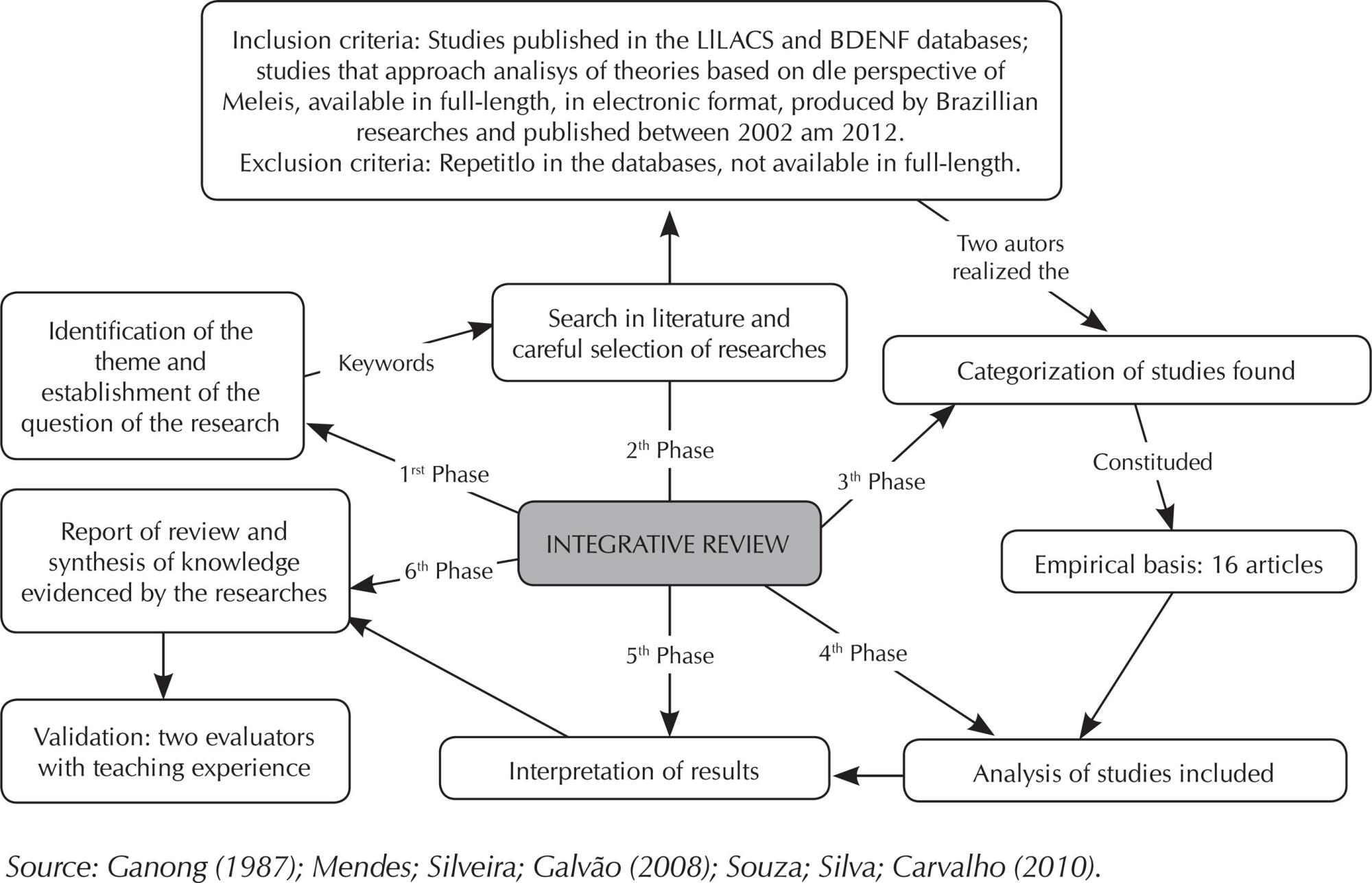
-
01-01-2016
Clinical indicators of sexual dysfunction in pregnant women: integrative literature review
Revista Brasileira de Enfermagem. 2016;69(1):165-173
Abstract
Clinical indicators of sexual dysfunction in pregnant women: integrative literature review
Revista Brasileira de Enfermagem. 2016;69(1):165-173
DOI 10.1590/0034-7167.2016690122i
Views0See moreABSTRACT
Objective:
to identify the nursing diagnosis clinical indicators of sexual dysfunction in pregnant women.
Method:
it is an integrative literature review, with research in databases using the keywords “sexual*”, “pregnan*” and “function*”. Studies included had an abstract available for analysis, referring to pregnant women over 18 years old, written in Portuguese, French, Spanish and English, with publication date between 2010 and 2014. Studies that reporting pregnant women with an associated pathology were excluded.
Results:
sexual dysfunction in pregnant women is consistent in the literature. Nine defining characteristics were identified and 16 related factors, some not classified in NANDA International.
Conclusion:
clinical indicators can be added to the nursing diagnosis to favor an accurate diagnosis and effective interventions in the surveillance of pregnancy as a period of healthy sexual experience.
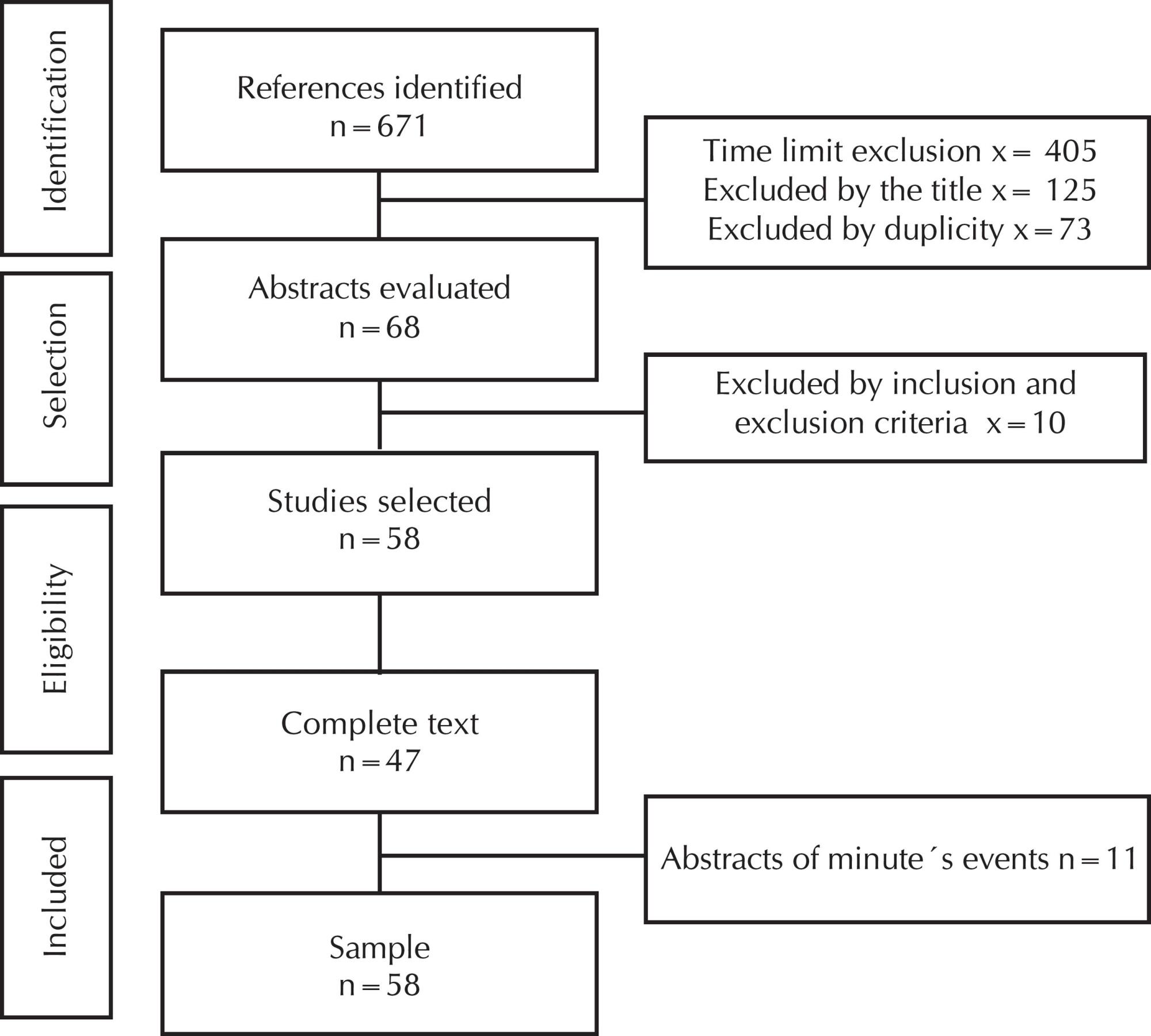
-
01-01-2016
Conditions of functional health literacy of an elderly diabetics group
Revista Brasileira de Enfermagem. 2016;69(1):156-164
Abstract
Conditions of functional health literacy of an elderly diabetics group
Revista Brasileira de Enfermagem. 2016;69(1):156-164
DOI 10.1590/0034-7167.2016690121i
Views0See moreABSTRACT
Objective:
to evaluate the conditions of functional health literacy of an elderly diabetics group.
Method:
cross-sectional and descriptive study, with diabetic’s elderly assisted in the SUS (N = 114). The social and health conditions were evaluated as well as functional health literacy by S-TOFHLA test (short version); the simple proportions, average, standard deviation and Pearson’s Chi-square were described by SPSS software (20.0) with α = 5% value.
Results:
the mean age was 67.4 years, 74.0% of the elderly were women, had up to four years of schooling; 29.8% had a long-standing illness, 64.0% reported having high blood pressure, 47.4% smoke or were smokers, 73.7% had low functional health literacy, which was associated with schooling p = 0.001.
Conclusions:
the low functional health literacy could be a self-care conditioning and can be influenced by low schooling because it implies to have skills to understand and make decisions aimed at self-management of health.
-
ORIGINAL ARTICLE07-14-2021
Impact of the contamination time by Escherichia coli on biofilm formation in surgical instruments
Revista Brasileira de Enfermagem. 2021;74(3):e20200759
Abstract
ORIGINAL ARTICLEImpact of the contamination time by Escherichia coli on biofilm formation in surgical instruments
Revista Brasileira de Enfermagem. 2021;74(3):e20200759
DOI 10.1590/0034-7167-2020-0759
Views1See moreABSTRACT
Objectives:
to evaluate the microbial load and adherence of Escherichia coli in different areas of the surgical instrument surface exposed to experimental contamination over time.
Methods:
experimental study in which fragments of crile forceps (serrated, rod and rack) were contaminated by immersion in Tryptic Soy Broth, containing 106 CFU/mL of E. coli, for 1, 2, 4, 6, 8, 12 and 24 hours. Microbial load and bacterial adherence were evaluated using microbiological culture and scanning electron microscopy, respectively.
Results:
there was an increase in the microbial load on the surgical instrument, proportional to the contamination interval, ranging from 102 after 1 hour to 105 CFU/cm2 in 24 hours. The presence of exopolysaccharide was detected after two hours of contamination.
Conclusions:
microbial load and adhesion of E. coli increased over time, reaching 105 CFU/cm2 after 24 hours of contamination, starting biofilm formation after two hours.
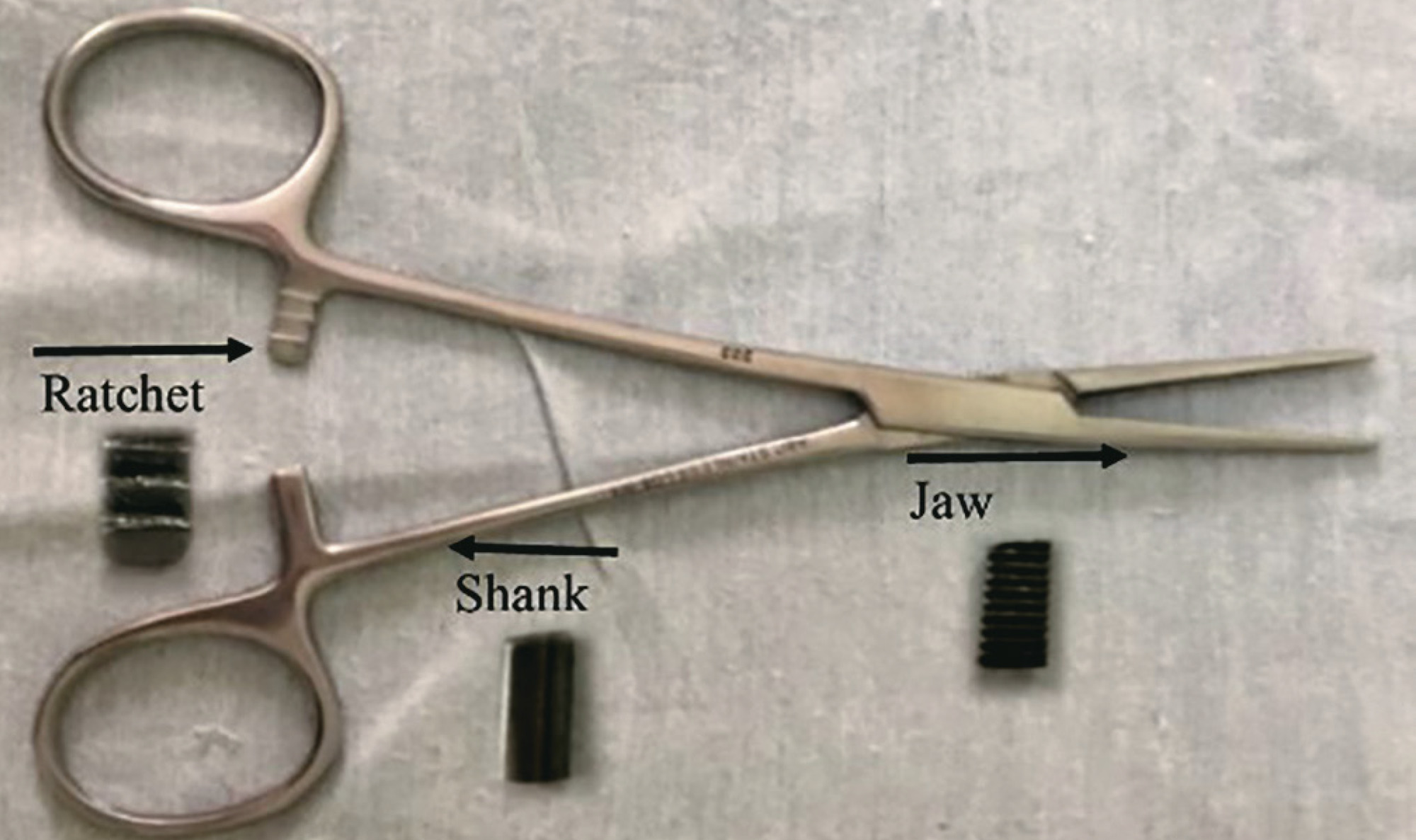
-
REVIEW07-09-2021
Breast cancer screening in Primary Health Care in Brazil: a systematic review
Revista Brasileira de Enfermagem. 2021;74(3):e20200995
Abstract
REVIEWBreast cancer screening in Primary Health Care in Brazil: a systematic review
Revista Brasileira de Enfermagem. 2021;74(3):e20200995
DOI 10.1590/0034-7167-2020-0995
Views1See moreABSTRACT
Objectives:
to analyze care strategies for breast cancer screening in Primary Health Care in Brazil.
Methods:
this is a systematic review following the Cochrane Collaboration recommendations.
Results:
among 355 manuscripts, five were eligible. The patient navigation program by Community Health Agent stood out with the best result, among the strategies: flexibility of goals considering viability; community engagement; team training; active search of the target population by Community Health Agent; request for mammography by physicians; actions integrated to women’s health; monitoring of mammography results, absent users, and population coverage by physician and nurse; and assessment of criteria for requesting screening mammography by means of an information system. The population coverage rate in the program ranged from 23% to 88%.
Conclusions:
Primary Health Care in Brazil presents devices with potential to induce the production of care for breast cancer screening.
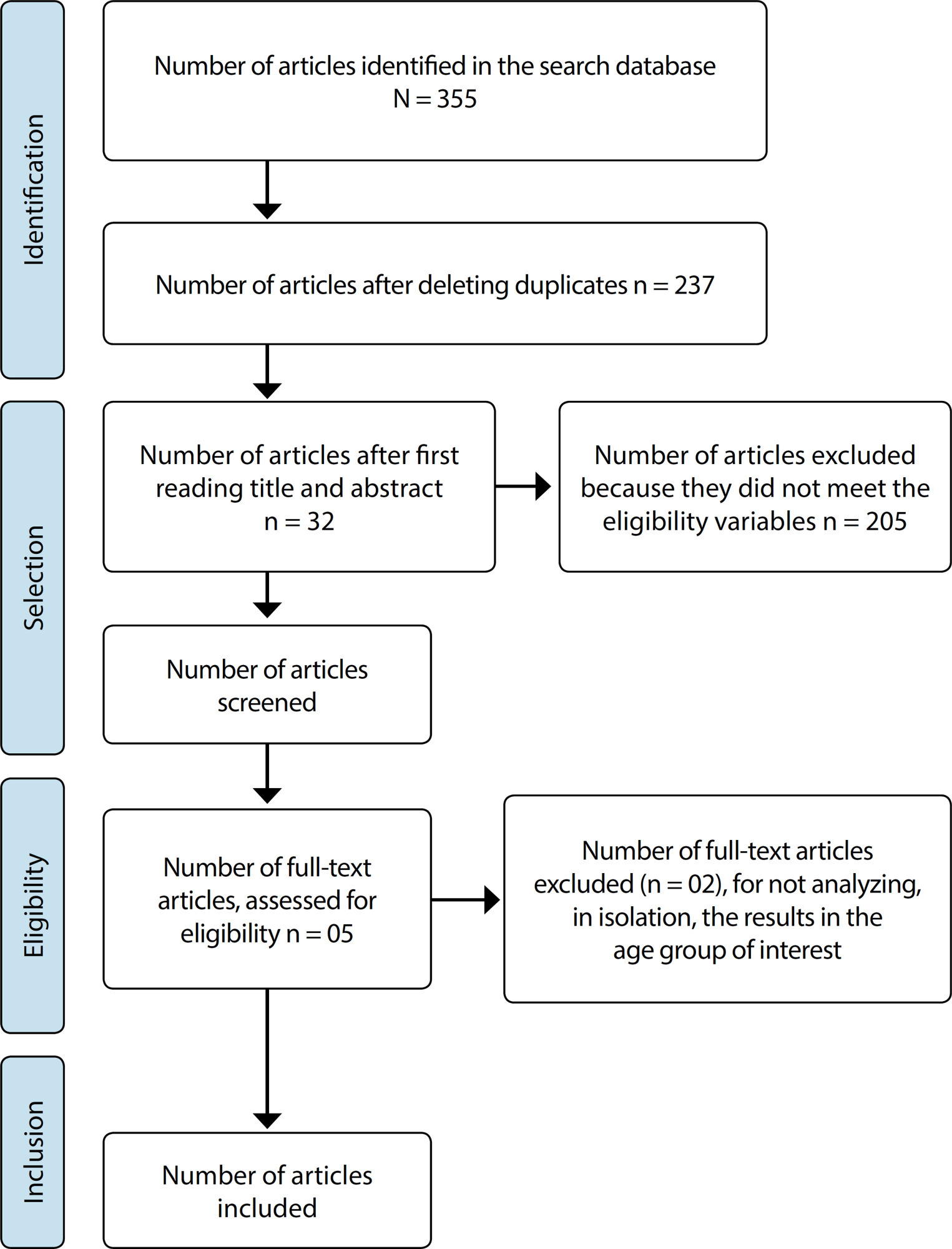
-
ORIGINAL ARTICLE06-18-2021
Spatial-temporal analysis of leprosy in a priority Brazilian northeast municipality for disease control
Revista Brasileira de Enfermagem. 2021;74(3):e20201101
Abstract
ORIGINAL ARTICLESpatial-temporal analysis of leprosy in a priority Brazilian northeast municipality for disease control
Revista Brasileira de Enfermagem. 2021;74(3):e20201101
DOI 10.1590/0034-7167-2020-1101
Views0See moreABSTRACT
Objectives:
to analyze the spatial-temporal distribution of leprosy in a priority municipality for leprosy control.
Methods:
ecological study, conducted in a city in the Northeast of Brazil, whose analysis units were census sectors. The study used compulsory notification data for cases registered between 2008 and 2017. TerraView software and the Batch Geocode tool was used for geocoding. The detection of spatial-temporal agglomerations of high relative risks was done by scanning statistics.
Results:
the spatial-temporal distribution of cases was heterogeneous, creating four agglomerations of high relative risks in the urban area of the municipality between the years 2008 and 2012; and annual prevalence rates classified from high to hyperendemic.
Conclusions:
areas of higher risk and concentration of the disease in space-time were linked to the characteristics of high population density and social vulnerability of these spaces, raising the prioritization of health professionals’ actions, systems, and services for control, and monitoring the disease.
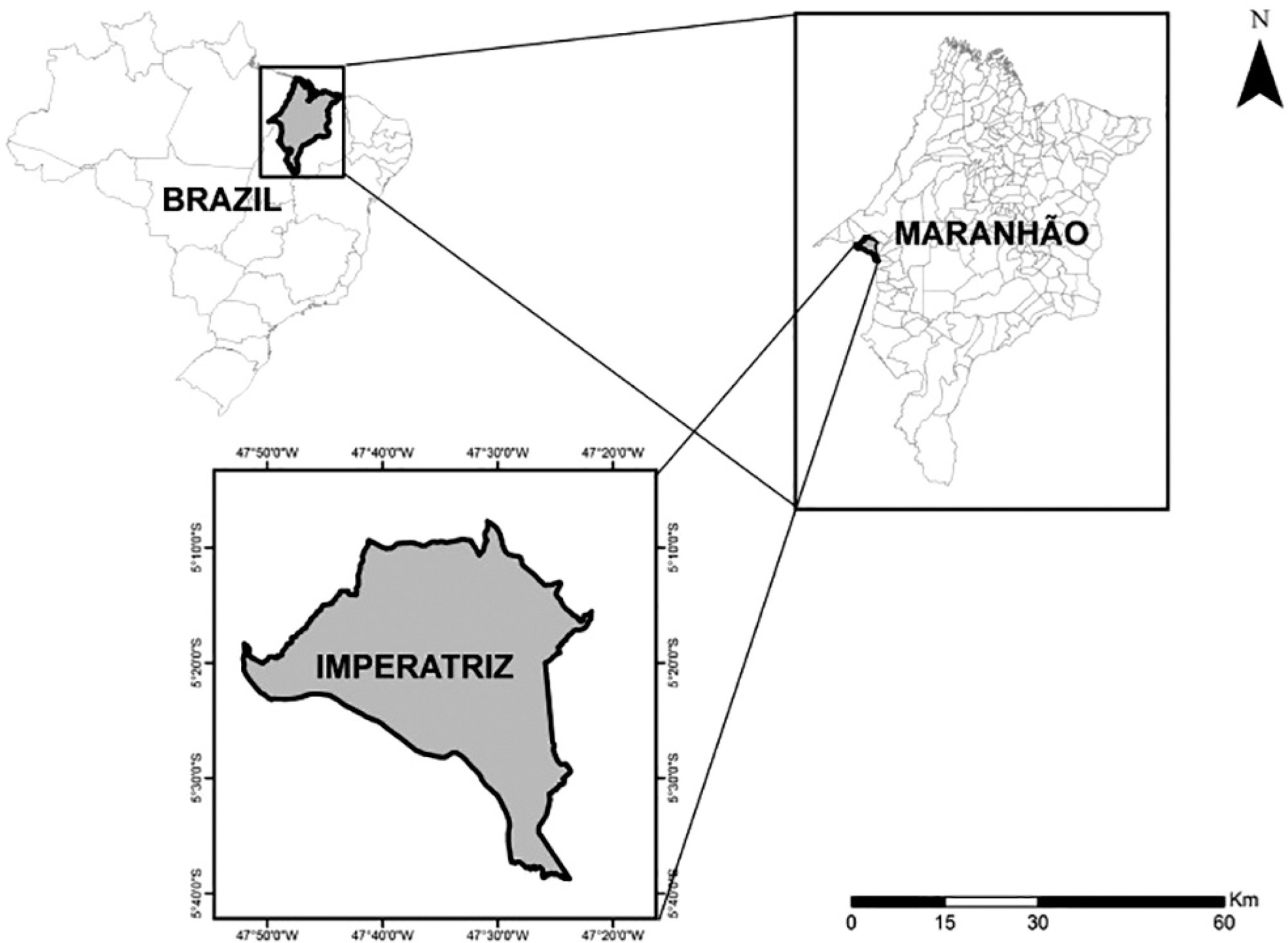
-
ORIGINAL ARTICLE06-18-2021
Assessment of the implementation of a nurse-initiated pain management protocol in the emergency department
Revista Brasileira de Enfermagem. 2021;74(3):e20201303
Abstract
ORIGINAL ARTICLEAssessment of the implementation of a nurse-initiated pain management protocol in the emergency department
Revista Brasileira de Enfermagem. 2021;74(3):e20201303
DOI 10.1590/0034-7167-2020-1303
Views0See moreABSTRACT
Objectives:
to assess the implementation of a nurse-initiated pain management protocol for patients triaged as semi-urgent, and its impact in pain intensity, in the Emergency Department.
Methods:
a prospective cohort study for adult patients with pain who had been triaged as semi-urgent and admitted to the hospital’s Emergency Department. Patients who received the intervention (pain-management protocol with analgesic administration) were compared to those who were managed using the conventional approach (physician evaluation prior to analgesic administration).
Results:
of the 185 patients included, 55 (30%) received the intervention, and 130 (70%) were managed conventionally. Patients in the intervention group were more likely to have taken pain medication in the 4 hours prior to admission, and reported higher levels of pain at admission and more significant reductions in pain level.
Conclusions:
despite low protocol adherence, the intervention resulted in higher reported pain relief.
-
ORIGINAL ARTICLE09-10-2021
Contradicting perceptions of nursing teachers on the neoliberal context of labor
Revista Brasileira de Enfermagem. 2021;74(4):e20200056
Abstract
ORIGINAL ARTICLEContradicting perceptions of nursing teachers on the neoliberal context of labor
Revista Brasileira de Enfermagem. 2021;74(4):e20200056
DOI 10.1590/0034-7167-2020-0056
Views0See moreABSTRACT
Objectives:
To identify and analyze the perceptions of nursing teachers on the new configurations of the job world and the repercussions for their labor activities.
Methods:
Qualitative, descriptive, exploratory research, carried out at two federal nursing colleges in Rio de Janeiro. Data collection occurred with 27 nursing teachers, between May and June 2016, through semi-structured interviews. The data were treated using the thematic content analysis technique.
Results:
The results showed contradictions in the teachers’ perceptions about the job world, which has been guided by neoliberal precepts. Such contradictions are characterized by manifestations in favor of incorporating these precepts, highlighting their negative effects on nursing teaching work.
Final considerations:
There are incongruities in the way of perceiving the current configuration of the job world, proposing more and profound reflections on such a work scenario.
-
ORIGINAL ARTICLE06-04-2021
Association between early pregnant hospitalization and use of obstetric interventions and cesarean: a cross-sectional study
Revista Brasileira de Enfermagem. 2021;74(4):e20200397
Abstract
ORIGINAL ARTICLEAssociation between early pregnant hospitalization and use of obstetric interventions and cesarean: a cross-sectional study
Revista Brasileira de Enfermagem. 2021;74(4):e20200397
DOI 10.1590/0034-7167-2020-0397
Views0See moreABSTRACT
Objective:
Evaluate the association between early pregnant hospitalization and the use of obstetric interventions and cesarean delivery route.
Methods:
Cross-sectional study, with 758 women selected at the time of childbirth. It was assumed as early hospitalization when the woman was admitted to the hospital having less than 6 cm of cervical dilation. Logistic regression models were constructed in order to estimate the odds ratio for each obstetric intervention, adjusted by sociodemographic and obstetric variables.
Results:
73.22% of women were early hospitalized. On average, they had 1.97 times the chance to undergo Kristeller’s maneuver, 2.59 and 1.80 times the chance to receive oxytocin infusion and analgesia, respectively, and 8 times more chances to having their children by cesarean delivery when compared to women that had timely hospitalization.
Conclusion:
Early hospitalized women were submitted to a higher number of obstetric intervention and had increased chances of undergoing cesarean sections.
-
ORIGINAL ARTICLE07-30-2021
Meaning of aging for caregivers of senile elderly people
Revista Brasileira de Enfermagem. 2021;74(4):e20201240
Abstract
ORIGINAL ARTICLEMeaning of aging for caregivers of senile elderly people
Revista Brasileira de Enfermagem. 2021;74(4):e20201240
DOI 10.1590/0034-7167-2020-1240
Views0See moreABSTRACT
Objectives:
to understand the meaning of aging for caregivers of senile elderly people.
Methods:
qualitative study carried out with 12 caregivers of elderly people registered in the Home Care Service, adopting the Explanatory Model of Kleinman’s Disease as a theoretical framework. Data were collected from April to June 2019, through semi-structured, audio-recorded interviews, carried out at home and submitted to content analysis.
Results:
taking care of senile elderly people triggers reflections on aging that sometimes lead to a new meaning of this process, besides stimulating the recognition of the factors that influence it, with emphasis on the life history, occupation and deleterious behaviors adopted throughout life.
Final Considerations:
the care experience influences the meaning attributed to aging, favoring: the identification of modifiable and non-modifiable aspects and behaviors that make it healthy; reflection on aging itself, with a new meaning of habits and behaviors to be adopted.
-
ORIGINAL ARTICLE07-30-2021
Curricular reforms in the transformation of nursing teaching in a federal university
Revista Brasileira de Enfermagem. 2021;74(4):e20201242
Abstract
ORIGINAL ARTICLECurricular reforms in the transformation of nursing teaching in a federal university
Revista Brasileira de Enfermagem. 2021;74(4):e20201242
DOI 10.1590/0034-7167-2020-1242
Views1See moreABSTRACT
Objectives:
to discuss the curricular reforms adopted for nursing teaching in Brazil, from 1969 to 2019.
Methods:
historical, qualitative approach using the thematic oral history and document research. 13 interviews were carried out with graduation nursing professors from a federal university in the South of Brazil. The document sources were the political-pedagogical projects of the course and their associated documents. Minayo’s thematic analysis was used.
Results:
nursing curricula delineates the profile of the professional that must be formed and are reviewed in order to be adapted to social and educational changes, showing the scientific and professional potential of the nurse. Curricular reforms consider the quality of nursing formation.
Final Considerations:
the structure of the curriculum and the reforms that took place emerged according to the historical, political, epidemiological and social context demanded from the profession, to attend to the demands of society and to the work market.
Search
Search in:
Nuvem de Tags
Adolescente (85) Atenção Primária à Saúde (239) COVID-19 (91) Criança (91) Cuidados de Enfermagem (269) Educação em Enfermagem (151) Educação em Saúde (139) Enfermagem (930) Enfermagem Pediátrica (86) Estudantes de Enfermagem (77) Estudos de Validação (131) Família (87) Idoso (208) Promoção da Saúde (99) Qualidade de Vida (104) Saúde do Trabalhador (86) Saúde Mental (145) Saúde Pública (82) Segurança do Paciente (150) Tecnologia Educacional (100)



